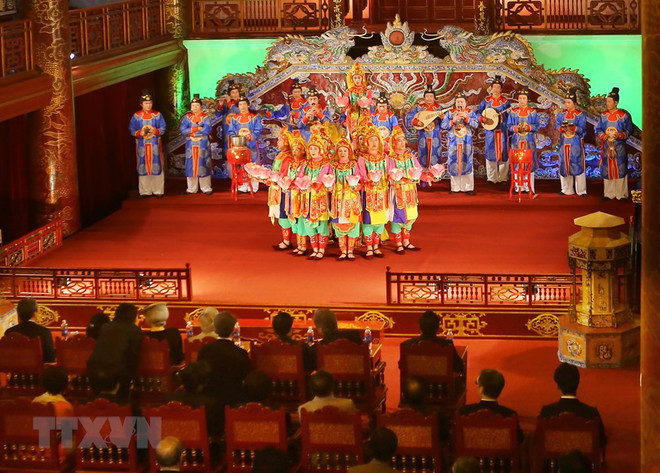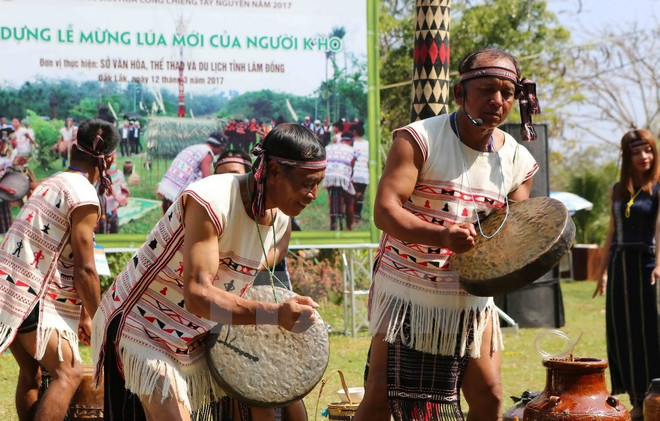Hanoi (VNA) – Vietnam possesses an array ofintangible cultural heritages that have been recognized by UNESCO.
1. Nha Nhac -Vietnamese court music
Inscribed in 2008 on the Representative List of theIntangible Cultural Heritage of Humanity (originally proclaimed in 2003), NhaNhac, meaning “elegant music” refers to a broad range of musical and dancestyles performed at the Vietnamese royal court from the 15th to themid-20th century.
Nha Nhac was generally featured at the opening and closing ofceremonies associated with anniversaries, religious holidays, coronations,funerals and official receptions. Among the numerous musical genres thatdeveloped in Vietnam, only Nha Nhac can claim a nationwide scope and stronglinks with the traditions of other East Asian countries.
Nha Nhac performances formerly featured numerous singers,dancers and musicians dressed in sumptuous costumes. Large-scale orchestrasincluded a prominent drum section and many other types of percussioninstruments as well as a variety of wind and string instruments.
All performers had to maintain a high level of concentrationsince they were expected to follow each step of the ritual meticulously. NhaNhac developed during the Le dynasty (1427-1788) and became highlyinstitutionalised and codified under the Nguyen monarchs (1802-1945).
As a symbol of the dynasty’s power and longevity, Nha Nhacbecame an essential part of the court’s ceremonies. However, the role of NhaNhac was not limited to musical accompaniment for court rituals: it alsoprovided a means of communicating with and paying tribute to the gods and kingsas well as transmitting knowledge about nature and the universe. Certain formsof Nha Nhac have been maintained in popular rituals and religious ceremoniesand serve as a source of inspiration for contemporary Vietnamese music.
2. Space of gongculture
Inscribed in 2008 on the Representative List of theIntangible Cultural Heritage of Humanity (originally proclaimed in 2005), thecultural space of the gongs in the Central Highlands of Vietnam is closelylinked to the daily life of local people. Their belief systems form a mysticalworld where the gongs produce a privileged language between men, divinities andthe supernatural world.
Behind every gong hides a god or goddess. Every familypossesses at least one gong, which indicates the family’s wealth, authority andprestige. While a range of brass instruments is used in the various ceremonies,the gong alone is present in all the rituals of community life.
Each instrumentalist carries a different gong measuringbetween 25 and 80 cm in diameter. From three to twelve gongs are played by thevillage ensembles, which are made up of men or women. Different arrangementsand rhythms are adapted to the context of the ceremony, for example, the ritualsacrifice of the bullocks, the blessing of the rice or mourning rites.
3. Quan ho Bac Ninhfolk songs
Inscribed in 2009 on the Representative List of theIntangible Cultural Heritage of Humanity, the Quan ho Bac Ninh folk songs areperformed as alternating verses between two women from one village who sing inharmony, and two men from another village who respond with similar melodies,but with different lyrics. The women traditionally wear distinctive large roundhats and scarves; the men’s costumes include turbans, umbrellas and tunics.
The song lyrics express people’s emotional states of longingand sadness upon separation and the happiness of the meeting of lovers.
Quan ho singing is common at rituals, festivals, competitionsand informal gatherings, where guests will perform a variety of verses fortheir hosts before singing farewell. Younger musicians of both sexes maypractice the four singing techniques – restrained, resonant, ringing andstaccato – at parties organised around singing.
Quan ho songs demonstrate the spirit, philosophy and localidentity of the communities in this region, and help forge social bonds withinand between villages that share a cherished cultural practice.
4. Ca Tru singing
 Ca tru singing is in the List of Intagible Cultural Heirtage in Need of Urgent Safeguarding (Photo: VNA)
Ca tru singing is in the List of Intagible Cultural Heirtage in Need of Urgent Safeguarding (Photo: VNA)Inscribed in 2009 on the List of Intangible Cultural Heritagein Need of Urgent Safeguarding, Ca tru is a complex form of sung poetry foundin the north of Vietnam using lyrics written in traditional Vietnamese poeticforms.
Ca tru groups comprise three performers: a female singer whouses breathing techniques and vibrato to create unique ornamented sounds, whileplaying the clappers or striking a wooden box, and two instrumentalists whoproduce the deep tone of a three-stringed lute and the strong sounds of apraise drum.
Some Ca tru performances also include dance. The varied formsof Ca tru fulfill different social purposes, including worship singing, singingfor entertainment, singing in royal palaces and competitive singing.
Ca tru has 56 different musical forms or melodies, each ofwhich is called “the cach”. Folk artists transmit the music and poems thatcomprise Ca tru pieces by oral and technical transmission, formerly, withintheir family line, but now to any who wish to learn.
5. Giong festival ofPhu Dong and Soc temples
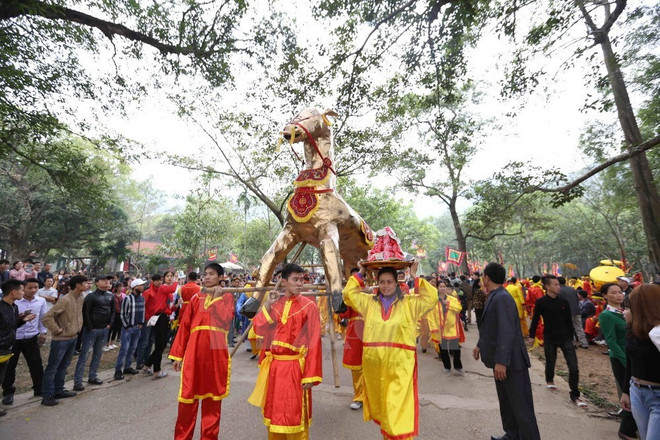 Giong Festival of Phu Dong and Soc temples was named part of intangible cultural heritage of humanity in 2010 (Photo VNA)
Giong Festival of Phu Dong and Soc temples was named part of intangible cultural heritage of humanity in 2010 (Photo VNA)Inscribed in 2010 on the Representative List of theIntangible Cultural Heritage of Humanity, the Giong festival of Phu Dong and Soctemples is celebrated annually in outlying districts of Hanoi, the capital ofVietnam.
Each spring, before the rice harvest, Vietnamese peoplehonour the mythical hero, god and saint, Thanh Giong, who is credited withdefending the country from foreign enemies, and is worshipped as the patron godof the harvest, national peace and family prosperity.
The festival at Phu Dong temple, which takes place in thefourth lunar month in the village of his birth, symbolically re-enacts hisfeats through the riding of a white horse into battle and the orchestration ofan elaborate flag dance to symbolise the battle itself. Young men receiveextensive training to play the roles of Flag Master, Drum Master, Gong Master,Army Master and Children’s Master, while 28 girls aged 9 to13 are selected to play the enemy generals. The Flag Master’s dancingmovements and drum and gong sounds convey the development of the battle, andpaper butterflies released from the flag symbolically disperse the invaders.
The arrival of rains after the festival is seen as a blessingfrom the saint for an abundant harvest. The celebrations at Soc temple, where SaintGiong ascended to heaven, take place in the first lunar month and include theritual of bathing his statue and a procession of bamboo flowers to the templeas offerings to the saint.
6. Xoan singing ofPhu Tho province
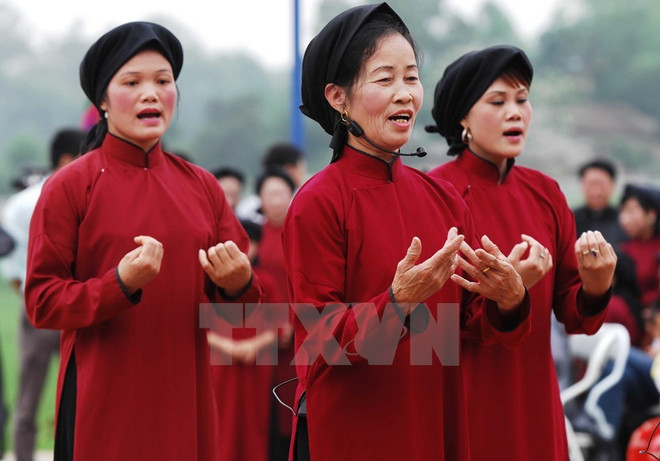 Recognised in 2011, Xoan singing of Phu Tho province is part of intagible cultural heritage in need of urgent safeguarding (Photo: VNA)
Recognised in 2011, Xoan singing of Phu Tho province is part of intagible cultural heritage in need of urgent safeguarding (Photo: VNA)Inscribed in 2017 on the Representative List of theIntangible Cultural Heritage of Humanity, Xoan singing in the northern provinceof Phu Tho includes singing, dancing, drumming and clapper beating.
It is closely linked to the worship of the Hung Kings, abelief rooted in the ancestor worship practice of Vietnamese people. Bearersand practitioners form four guilds, in which the male and female “Trum” playthe most important role: they preserve the songs, select students, transmit thesinging styles and repertoires and organise practices. They are also active inintroducing and teaching Xoan singing in clubs and guilds.
As a community performing art, Xoan singing fosters culturalunderstanding, community cohesion and mutual respect. The Vietnamese Institutefor Musicology has collected 31 Xoan songs, and thanks to the efforts ofseveral Xoan artists, four guilds have been established. Thirty-three dedicatedclubs also exist, and seminars are held to expand the knowledge of Xoan. SeniorXoan artists transmit the singing orally, combined with the use of writtensongs and audio and visual recordings.
7. Worship of HungKings in Phu Tho
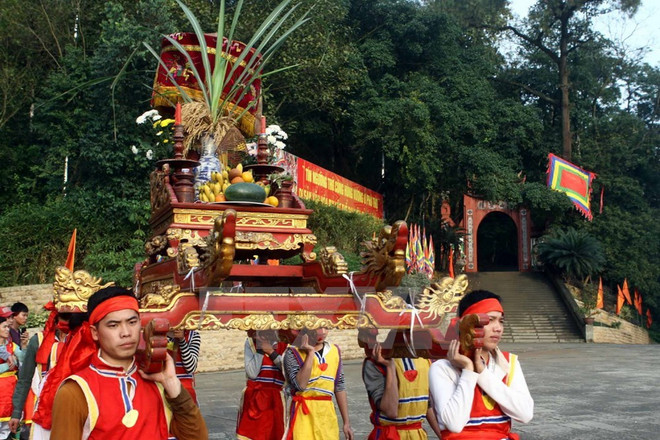 The worship of Hung Kings in Phu Tho province recognised as a UNESCO Intangible Cultural Heritage of Humanity in 2012. (Photo: VNA)
The worship of Hung Kings in Phu Tho province recognised as a UNESCO Intangible Cultural Heritage of Humanity in 2012. (Photo: VNA)Inscribed in 2012 on the Representative List of theIntangible Cultural Heritage of Humanity, the worship of Hung Kings in thenorthern province of Phu Tho draws millions of people annually to commemoratetheir ancestors and pray for good weather, abundant harvests, good luck andgood health.
The largest ceremony, the ancestral anniversary festival ofthe Hing Kings, is celebrated for about one week at the beginning of the thirdlunar month. People from surrounding villages dress in splendid costumes andcompete to provide the best palanquin and most highly valued objects of worshipfor the key rite in which drums and gongs are conveyed to the main temple site.
Communities make offerings of rice-based delicacies such assquare cakes and glutinous cakes, and there are verbal and folk artsperformances, bronze drum beating, Xoan singing, prayers and petitions.
8. Art of Don ca tai tu music andsong in southern Vietnam
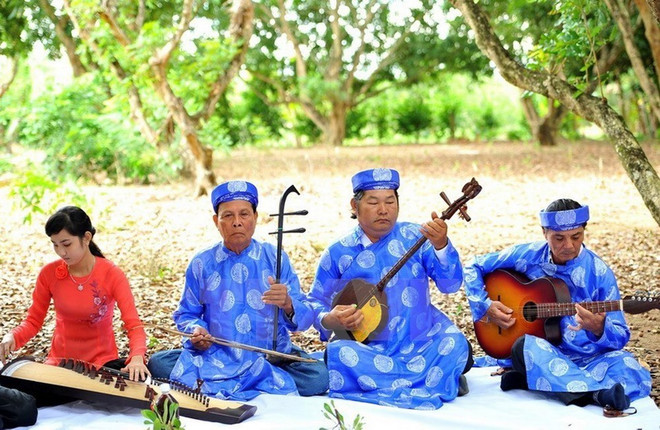 The art of Don ca tai tu music and song in southern Vietnam was named in the list of intangible cultural heirtage of humanity in 2013 (Photo: VNA)
The art of Don ca tai tu music and song in southern Vietnam was named in the list of intangible cultural heirtage of humanity in 2013 (Photo: VNA)Inscribed in 2013 on the Representative List of theIntangible Cultural Heritage of Humanity, the art of “Don ca tai tu” music andsong is an indispensable part of the spiritual activity and cultural heritageof people in the south of Vietnam.
The music and songs evoke the people’s life and work on theland and rivers of the Mekong Delta region. Performed at numerous events suchas festivals, death anniversary rituals and celebrations, “Don ca tai tu” isthus intimately connected with other cultural practices and customs, oraltraditions and handicrafts.
Performers express their feelings by improvising, ornamentingand varying the skeletal melody and main rhythmic patterns of these pieces. “Donca tai tu” is played on a variety of different instruments, including themoon-shaped lute, two-stringed fiddle, sixteen-stringed zither, pear-shapedlute, percussion, monochord and bamboo flute. Its repertoire is based on twentyprincipal songs and seventy-two classical songs.
The musical art is passed on through oral transmission, basedon imitation, from master instrumentalists and singers to students. Musiciansneed to study for at least three years to learn the basic instrumentaltechniques and master the musical modes to express different moods andemotions. Vocal students study the traditional songs and learn to improvisesubtly, using different ornamentation techniques.
9. Vi and Giam folk songs of NgheTinh
 Vi and Giam folk songs of Nghe Tinh are on the Representative List of the Intangible Cultural Heritage of Humanity (Photo VNA)
Vi and Giam folk songs of Nghe Tinh are on the Representative List of the Intangible Cultural Heritage of Humanity (Photo VNA)Inscribed in 2014 on the Representative List of theIntangible Cultural Heritage of Humanity, Vi and Giam songs are sung by a widerange of communities in the north-central provinces of Nghe An and Ha Tinh.
Specific songs are sung without instrumental accompanimentwhile people cultivate rice in the fields, row boats, make conical hats or lullchildren to sleep.
Vi and Giam lyrics use the specific dialect and linguisticidioms of the Nghe Tinh region and practitioners sing with the particularsinging voice of local people.
Many of the songs focus on key values and virtues includingrespect for parents, loyalty, care and devotion, the importance of honesty anda good heart in the maintenance of village customs and traditions.
Singing provides people with a chance to ease hardship whileworking, to relieve sorrow in their lives, express feelings of sentimentbetween men and women, and exchange feelings of love between unmarried boys andgirls.
Today Vi and Giam are commonly performed at community culturalevents and are sung by artists in theatres.
10. Tugging rituals and games
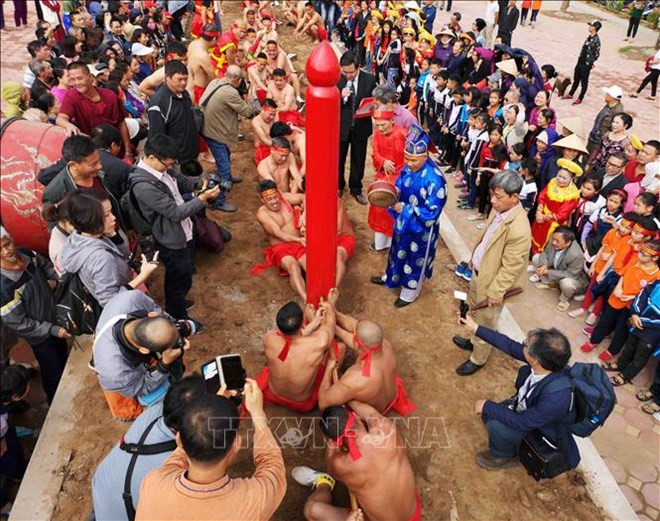 Tugging rituals and games in the rice-farming cultures of East Asia and Southeast Asia became part of the Intangible Cultural Heritage of Humanity in 2015 (Photo: VNA)
Tugging rituals and games in the rice-farming cultures of East Asia and Southeast Asia became part of the Intangible Cultural Heritage of Humanity in 2015 (Photo: VNA)Inscribed in 2015 on the Representative List of theIntangible Cultural Heritage of Humanity, tugging rituals and games in therice-farming cultures of East Asia and Southeast Asia are enacted amongcommunities to ensure abundant harvests and prosperity.
They promote social solidarity, provide entertainment andmark the start of a new agricultural cycle. Many tugging rituals and games alsohave profound religious significance. Most variations include two teams, eachof which pulls one end of a rope attempting to tug it from the other. Theintentionally uncompetitive nature of the event removes the emphasis on winningor losing, affirming that these traditions are performed to promote thewell-being of the community, and reminding members of the importance ofcooperation.
Many tugging games bear the traces of agricultural rituals,symbolising the strength of natural forces, such as the sun and rain while alsoincorporating mythological elements or purification rites.
Tugging rituals and games are often organised in front of avillage’s communal house or shrine, preceded by commemorative rites to localprotective deities. Village elders play active roles in leading and organisingyounger people in playing the game and holding accompanying rituals.
They also serve to strengthen unity and solidarity and senseof belonging and identity among community members.
11. Practices related to Vietnamesebeliefs in the Mother Goddesses of Three Realms
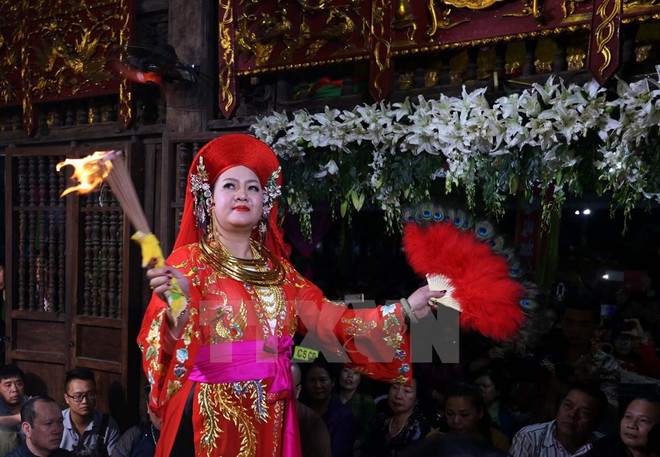 The practices related to the Viet beliefs in the Mother Goddesses of Three Realms are on the Representative List of the Intangible Cultural Heritage of Humanity (Photo: VNA)
The practices related to the Viet beliefs in the Mother Goddesses of Three Realms are on the Representative List of the Intangible Cultural Heritage of Humanity (Photo: VNA)Inscribed in 2016 on the Representative List of theIntangible Cultural Heritage of Humanity, the practices in the Mother Goddessesof Three Realms (heaven, water, and mountains and forests) aim to meetspiritual needs and everyday wishes of Vietnamese people.
The Mother Goddesses include Lieu Hanh (a nymph who descendedto earth, lived as a human and became a Buddhist nun) referred to as the Motherof the World, and other spirits considered legendary heroes. The traditionalpractice involves daily worship and participation in ceremonies, rituals likethe spirit possession ritual and festivals such as Phu Day that take place attemples dedicated to the Mother Goddesses. These activities associated with thepractice help to maintain part of the community’s history, cultural heritageand identity with some aspects incorporating traditional costumes, music anddance.
Bearers and practitioners are members of the public, templeguardians, ritual priests, spirit mediums, assistants and musicians whotransmit knowledge and skills orally to newcomers and family members. Thepractice of shared values and strong beliefs in the compassion and grace of theMother Goddesses provides a basis for social relations connecting members ofparticipating communities.
The worshipping of the Mother Goddesses also contributes tothe appreciation of women and their roles in society.
12. The art of BaiChoi in central Vietnam
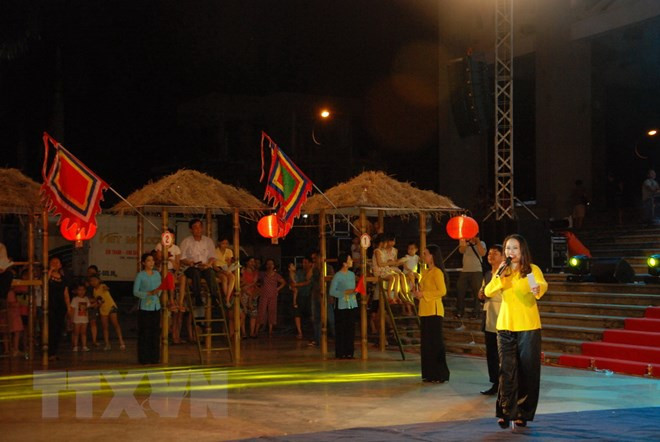 The art of Bai Choi in central Vietnam is part of the Representative List of the Intangible Cultural Heritage of Humanity (Photo: VNA)
The art of Bai Choi in central Vietnam is part of the Representative List of the Intangible Cultural Heritage of Humanity (Photo: VNA)Inscribed in 2017 on the Representative List of theIntangible Cultural Heritage of Humanity, the art of Bai Choi in centralVietnam is a diverse art combining music, poetry, acting, painting andliterature.
It takes two main forms: Bai Choi games and Bai Choiperformance. Bai Choi games involve a card game played in bamboo huts duringthe Lunar New Year. In Bai Choi performances, male and female artists performon a rattan mat, either moving from place to place or in private occasions forfamilies.
The art of Bai Choi is an important form of culture andrecreation within village communities. Performers and their families play amajor role in safeguarding the practice by teaching song repertoires, singingskills, performance techniques and card-making methods to younger generations.Together with communities, these performers have set up nearly 90 Bai Choiteams, groups and clubs to practise and transmit the art form, which attractswide community participation.
Most performers of the art learn their skills within thefamily and the skills are mainly transmitted orally, but artists specialisingin Bai Choi also transmit knowledge and skills in clubs, schools andassociations.
With 12 intangible cultural heritages recognized byUNESCO, Vietnam now ranks eighth out of 177 member nations of the Conventionfor the Safeguarding of the Intangible Cultural Heritage.-VNA
